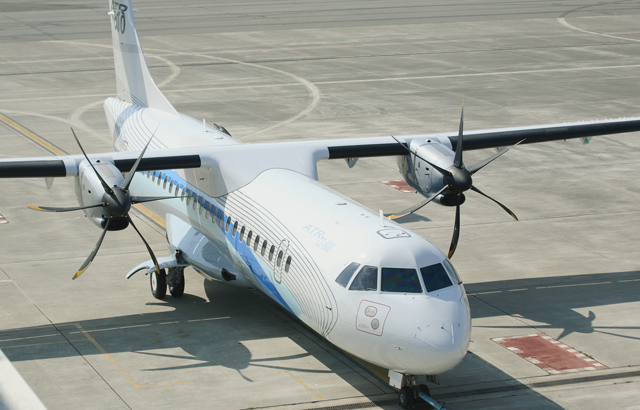It is possibly not a problem ATR thought it would ever have to face when its annual output languished in single figures a decade ago. But buoyant demand for the Toulouse-based airframer’s twin turboprops – it took a record 160 orders in 2014 – meant it has had to find a way of raising production beyond a capacity limit of eight aircraft a month. Its solution? Splitting its final assembly lines in two last year to allow it to go up to rate 10 by the end of 2015.
ATR’s recovery from the dark days of the early 2000s – when business jets threatened the extinction of commuter turboprops, which were seen as yesterday’s technology – has been well documented. But that change in fortunes created new challenges for the Airbus and Alenia Aermacchi joint venture: recharging a sleepy supply chain and a factory that in 2006 employed just 50 people and was designed to produce one or two aircraft a month.
Although output has been steadily growing since that time, the airframer took the decision to install a second final production line in late 2013. “Up until last year, we had just one line with a single stream, and this bottleneck limited us to eight aircraft per month,” says Raphael Dubus, ATR’s head of manufacturing. Space was cleared in the production hall to create a 5,000m2 “South” final assembly line. The hall dedicted to customisation of the aircraft was similarly divided in two.
The arrangement has created two new positions at each stage, meaning that ATR can have six – rather than four – aircraft at the same point of final assembly at any one time. Now the original “North” final assembly line will be able to produce six aircraft a month, with its “South” sister adding four. Some 500 production line staff work in two shifts – 06:00 to 16:00 and 16:00 to midnight – with a smaller crew shifting aircraft overnight into the optimal position for the next day.
The forerunners of Airbus and Alenia Aermacchi – Aérospatiale and Aeritalia – came together as ATR in 1981, merging their respective regional turboprop designs into the 50-seat ATR-42 (the 50-seat ATR-72 was added five years later). Today, the assembly process reflects the 50:50 Franco-Italian split, with sections of the aircraft produced by Alenia Aermacchi and Airbus sister companies in both countries.

Shareholders Airbus and Alenia Aermacchi are torn over a further stretch to the ATR 72
ATR
The wing is produced by Airbus subsidiary Stelia in Bordeaux and arrives in Toulouse by road. The fuselage is assembled in Naples, trucked to Rome, shipped to Barcelona and transported by motorway to the final assembly line. The French-built landing gear goes in the opposite direction, to be fitted in Italy. Racks and harnesses are added to the fuselage in Toulouse before the wings and avionics are installed at one of the twin first stages in the final assembly line proper.
The three-part empennage – built by Alenia Aermacchi at Foggia – is attached, before the product moves to the next station where the Pratt & Whitney PW127M engine – with Ratier Figeac propellers – is fitted. Aircraft are then moved to what ATR calls its line B, an adjacent hall on the sprawling Airbus complex at Blagnac, with space for 10 ATR-72s or 12 ATR-42s and where interiors are installed. Completed aircraft then move to the eight-position flight line for testing and delivery.
As well as redesigning its final assembly line to meet increased demand, ATR has also had to “change our approach” with its suppliers. “I need three things for a ramp-up,” says Dubus. “The human resources and industrial installations are done. The supply chain is to follow.” ATR has deployed carrot and stick, requiring its first-tier suppliers to invest in adding capacity but at the same time offering them “a big visibility for the future”.
This has involved six months of firm orders – previously three months – and what Dubus calls a “three-year visibility”, meaning it shares production plans for that period with key suppliers. ATR now has 1,200 direct employees but it is also responsible for 6,000 supply chain jobs, and Dubus says it is in ATR’s interest to keep those suppliers strong. When it detects weakness in the chain, it can send in consultants to sort the problem under a scheme sponsored by French trade body GIFAS.
The efforts are paying off. Three years ago, says Dubus, 60% of deliveries to ATR were on time. This has risen to 90% for 2014 and “our target for the end of this year is 95%”. Although ATR bosses have said publically that they expect production to stabilise at around 100 a year, Dubus says it is his job to do all he can to push capacity up further “so there is still that margin to increase if demand is still booming”.
ATR’s shareholders remain torn over a further stretch to the ATR-72 – which represents 90% of ATR production – to create a 90-seat variant. The Italian co-owners are apparently keen to push into this new, untapped segment, but the French are content to reap the profits from a mature but still extremely popular programme. With no agreement in the boardroom and a backlog of around 280 of the current versions, any prospect of a larger turboprop seems some way away.
Source: Flight International
















